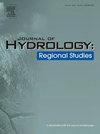中国黄土高原生态系统用水效率的时空异质性及其驱动机制
IF 4.7
2区 地球科学
Q1 WATER RESOURCES
引用次数: 0
摘要
研究区域中国黄土高原研究重点以生态系统水分利用效率(WUE)为特征的碳吸收与水分损失之间的权衡深刻影响着生态系统的可持续性。本研究根据中分辨率成像分光仪(MODIS)产品的 GPP 和普利斯特里-泰勒喷气推进实验室(PT-JPL)模型模拟的蒸散发估算水分利用效率。新出现的热点分析(EHSA)用于全面研究 WUE 的时空异质性。结果表明,在不同植被和水文气候条件下,WUE 具有明显的空间异质性。在经历了大规模生态恢复和农业集约化的亚湿润耕地和草地地区,WUE 显著增加。相比之下,在半干旱的草地地区,WUE 则略有下降,其中一些地区还伴随着冷斑的加剧。值得注意的是,在一些植被覆盖率过高的热点地区,WUE 也呈轻微下降趋势。此外,耕地/森林/草地的 WUE 模式主要受植被覆盖率(以归一化差异植被指数表征)和降水/气温/蒸气压差的相互作用影响,其中归一化差异植被指数起主导作用,水文气候驱动因素起辅助作用。本文章由计算机程序翻译,如有差异,请以英文原文为准。
Spatio-temporal heterogeneity and driving mechanism of ecosystem water use efficiency in the Loess Plateau, China
Study region
The Loess Plateau, China
Study focus
The trade-off between carbon uptake and water loss, characterized by ecosystem water use efficiency (WUE), deeply influences ecosystem sustainability. In this study, WUE was estimated based on GPP from the Moderate Resolution Imaging Spectroradiometer (MODIS) product and ET simulated by the Priestley Taylor Jet Propulsion Laboratory (PT-JPL) model. The emerging hot spot analysis (EHSA) was used to comprehensively examine the spatio-temporal heterogeneity of WUE. Additionally, the Geodetector model was employed to identify the main drivers of WUE and quantify the interactive effects of drivers on WUE, focusing on different vegetation types.
New hydrological insights for the region
Results indicated obvious spatial heterogeneity of WUE under different vegetation and hydro-climatic conditions. Significant increases in WUE occurred in sub-humid cropland and grassland areas that have experienced large-scale ecological restoration and agricultural intensification. By contrast, slight decreases in WUE were observed in semi-arid grassland areas, some of which were accompanied by intensifying cold spots. It was noteworthy that WUE in some hot spots with excessive vegetation coverage also showed a slight downward trend. Further, the WUE pattern in cropland/forests/grassland was dominated by the interaction of vegetation coverage (characterized by the Normalized Difference Vegetation Index, NDVI) and precipitation/air temperature/vapor pressure deficit, with NDVI playing a leading role and hydro-climatic drivers playing a supporting role.
求助全文
通过发布文献求助,成功后即可免费获取论文全文。
去求助
来源期刊

Journal of Hydrology-Regional Studies
Earth and Planetary Sciences-Earth and Planetary Sciences (miscellaneous)
CiteScore
6.70
自引率
8.50%
发文量
284
审稿时长
60 days
期刊介绍:
Journal of Hydrology: Regional Studies publishes original research papers enhancing the science of hydrology and aiming at region-specific problems, past and future conditions, analysis, review and solutions. The journal particularly welcomes research papers that deliver new insights into region-specific hydrological processes and responses to changing conditions, as well as contributions that incorporate interdisciplinarity and translational science.
 求助内容:
求助内容: 应助结果提醒方式:
应助结果提醒方式:


